
![]()
Search the Journey to Forever website – click HERE
|
Journey to Forever: Make a donation |
Navigation
| Small farms library | |
| City farms | |
| Organic gardening | |
| Composting | |
| Small farms | |
| Introduction Sustainable farming Small farms fit References |
|
| Small farm resources | |
| Back to the land | |
| Small farms | |
| Organics | |
| Soil management | |
| Sustainable farming | |
| General resources | |
| Food storage and preservation | |
| Useful databases | |
| Community-supported farms | |
| Farming with trees | |
| Agroforestry Bamboo Resources |
|
| Farming with animals | |
| Introduction Livestock resources Cattle Sheep General Draft animals |
|
| Pasture | |
| Introduction Pasture resources Silage |
|
| Pigs for small farms | |
| Why pigs have snouts Raising pigs on soil in Japan Lady Eve's pigs Pigs on pasture Pig resources |
|
| Poultry for small farms | |
| Muscovy ducks Khaki Campbell ducks Chickens Geese Rabbits Guineafowl General tips High-protein poultry feed from thin air Poultry as unpaid labour They're not pets Doing it |
|
| Poultry resources | |
| Aquaculture for small farms | |
| Introduction Aquaculture resources |
|
| Composting for small farms | |
| Foundation On-farm composting resources |
|
| Controlling weeds and pests | |
| Weeds Weed control resources Insect pests No pesticides Insect control resources |
|
Contact usTo Keith Addison Handmade Projects |
Farming with trees
-- "When we develop an agriculture that fits the land, it will become an almost endless vista of green, crop-yielding trees." -- J. Russell Smith, "Tree Crops: A Permanent Agriculture", 1929
-- "What are the main principles underlying Nature's agriculture? These can most easily be seen in operation in our woods and forests. Mixed farming is the rule: plants are always found with animals: many species of plants and of animals all live together. In the forest every form of animal life, from mammals to the simplest invertebrates, occurs. The vegetable kingdom exhibits a similar range: there is never any attempt at monoculture: mixed crops and mixed farming are the rule." -- Sir Albert Howard, "An Agricultural Testament", 1940. See Nature's agriculture (Go on -- click it! You'll be glad you did.)
-- "The marriage of forestry and farming must be included in all our future agricultural policies." -- Sir Albert Howard, "Farming and Gardening for Health or Disease (The Soil and Health)", 1945
-- "In order for humid tropical agriculture to be both highly productive and sustainable, it must imitate the highly productive, millions-of-years-old humid tropical forest" -- Roland Bunch, "An Odyssey of discovery: principles of agriculture for the humid tropics", ILEIA Newsletter Vol. 11 No. 3 (October 1995): "We Love Weeds"
-- "Agroforestry is possibly the most self-sustaining and ecologically sound of any agricultural system." -- Dr. Franklin W. Martin, "Agroforestry Principles", ECHO Technical Note, 1992
Agroforestry
Agroforestry integrates trees with farming, such as lines of trees with crops growing between them (alley cropping), hedgerows, living fences, windbreaks, pasture trees, woodlots, and many other farming patterns.
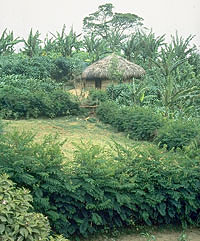
A livestock enclosure formed by a living fence of thorny Caesalpinia trees that the livestock won't eat
There's nothing new about it -- it only seems new because modern industrialized farming ("commodity extraction" rather than farming) has veered so far from true farming practices. The heavy machines and single-crop production lines are tree-unfriendly.
Previously, many traditional farming systems all over the world integrated trees with crops and livestock, and many continue to do so. The traditional European mixed farm with its crop and livestock rotations over the land was alive with trees, in hedgerows, pastures and woodlots, lining lanes, around homesteads. Such farms are still to be found in many parts of Europe.
Now agroforestry is perhaps the fastest growing sector of the sustainable farming movement, in both the developed countries and the Third World.
Agroforestry increases biodiversity, supports wildlife, provides firewood, fertilizer, forage, food and more, improves the soil, improves the water, benefits the farmers, benefits everyone.
Resources
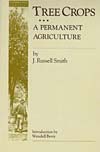 Tree Crops -- A Permanent Agriculture, by J. Russell Smith, Harcourt-Brace, New York, 1929; Devin-Adair, Connecticut, 1950; Island Press Conservation Classics, 1987, ISBN 0-933289-44-0
Tree Crops -- A Permanent Agriculture, by J. Russell Smith, Harcourt-Brace, New York, 1929; Devin-Adair, Connecticut, 1950; Island Press Conservation Classics, 1987, ISBN 0-933289-44-0
Russell Smith was 50 years ahead of his time, writing the basic text on agroforestry long before there was such a thing. He travelled widely and saw it all coming. The best book about trees -- it's inspired generations of environmental activists, including all the leading lights in the movement. Wonderful! Introductory chapters online in the Small Farms Library. Download the complete book from CD3WD online library (58.8Mb pdf):
http://www.fastonline.org/CD3WD_40/JF/419/08-302.pdf
Buy the book from Amazon.com: Tree Crops: A Permanent Agriculture
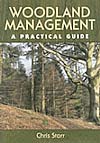 Woodland Management: A Practical Guide, by Chris Starr, Crowood Press (UK), 2005, ISBN 1861267894, 192 pages -- Whether you own woodland, are thinking of buying woodland, or just like trees, this comprehensive book will be of value to you. It covers buying and owning woodland; what to look for and how to avoid pitfalls; creating new woodland and factors influencing the choice of tree species; developing a management plan; broadleaves and conifers; the seasonal cycle and practical tasks; timber production and income generation from other sources; habitat and wildlife conservation. Buy at Amazon.com: Woodland Management: A Practical Guide
Woodland Management: A Practical Guide, by Chris Starr, Crowood Press (UK), 2005, ISBN 1861267894, 192 pages -- Whether you own woodland, are thinking of buying woodland, or just like trees, this comprehensive book will be of value to you. It covers buying and owning woodland; what to look for and how to avoid pitfalls; creating new woodland and factors influencing the choice of tree species; developing a management plan; broadleaves and conifers; the seasonal cycle and practical tasks; timber production and income generation from other sources; habitat and wildlife conservation. Buy at Amazon.com: Woodland Management: A Practical Guide
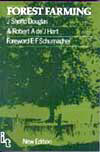 "Forest Farming: Towards a solution to problems of world hunger and conservation" by J. Sholto Douglas & Robert de J. Hart, Rodale Press, 1978, Practical Action, 1984, ISBN 0946688303
"Forest Farming: Towards a solution to problems of world hunger and conservation" by J. Sholto Douglas & Robert de J. Hart, Rodale Press, 1978, Practical Action, 1984, ISBN 0946688303
The integration of tree and other farming establishes a sounder ecological balance and greater productivity of food and materials for clothing, fuel and shelter. Only 8-10% of the world's surface is currently used for food production, but planting of crop-yielding trees could raise that figure to 75%. The book suggests planting and cropping methods and a range of potentially useful trees. Foreword by Fritz Schumacher ("Small is Beautiful"). Download complete book free from CD3WD online library (22Mb pdf):
http://www.fastonline.org/CD3WD_40/JF/419/08-307.pdf
Buy the book from the Development Bookshop: Forest Farming
Short Rotation Forestry -- As a Solar Energy Transducer and Storage System, by Geoffrey Stanford, Greenhills Foundation, Conference on Energy and Agriculture, St Louis, Missouri, June 1976. For 5,000 years, until around 1850, when coal became freely available, coppice wood was the only fuel available for homes as well as for industry in Europe. "Coppicing is almost unknown in the USA ... It is a technique of woodland husbandry which has an unbroken history in Europe which goes back at least 5,000 years. Under normal forestry management today we grow of the order of 0.5-10 tons of wood per acre per year -- the annual increment; the national norm is 1.5-3 tons/acre. By coppicing we can certainly achieve 5-10 tons annual increment immediately, and we can confidently expect that by normal agricultural programs of selection and mutation engineering we can raise that to 20-30 tons each year within a decade or two." Background, data, techniques -- a useful introduction. Download the full text free from CD3WD online library (3.6Mb pdf):
http://www.fastonline.org/CD3WD_40/JF/JF_VE/BIG/08-301.pdf
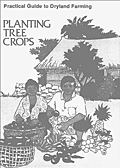 Planting Tree Crops -- Practical Guide to Dryland Farming, World Neighbors, 39 pages. A basic how-to guide for tropical countries, step-by-step, from seeds, seedlings and cuttings, through air-layering and grafting to establishment and care, well-illustrated with clear line drawings each step of the way. Download the full text free from CD3WD online library (3.7Mb pdf):
Planting Tree Crops -- Practical Guide to Dryland Farming, World Neighbors, 39 pages. A basic how-to guide for tropical countries, step-by-step, from seeds, seedlings and cuttings, through air-layering and grafting to establishment and care, well-illustrated with clear line drawings each step of the way. Download the full text free from CD3WD online library (3.7Mb pdf):
http://www.fastonline.org/CD3WD_40/
JF/JF_VE/BIG/08-323.pdf
"Agroforestry: A way of farming that can work for everyone" -- Overstory #7: Agroforestry (free on-line journal focusing on trees and crops in agroforestry) -- "There is growing concern throughout the world about the loss of species diversity. Much of the destruction has taken place to make room for human agriculture, particularly pastures, plantations, and other monocultures. Agroforestry systems increase species diversity within farming systems, providing for human needs while supporting wildlife, soil microorganisms, rural communities, farmers, economic interests, watersheds, clean air concerns, biodiversity, and more." Online:
http://www.agroforester.com/overstory/overstory7.html
agroforester.com -- Resource for Tropical Forestry and Agroforestry, based in Hawaii --  Publishes the Overstory free email journal for agroforesters, gardeners and others. Back issues online. Forest management plans, agroforestry plans, tree seedlings, tree seeds and plant inoculants (mycorrhiza and rhizobium), training and education workshops. Free publications: Nitrogen Fixing Tree Start-up Guide, Guide to Orchard Alley Cropping, Multipurpose Windbreaks, Multipurpose Palms, Forest Technology Bulletins, Sheet Mulching, more. Agroforestry links. Site search.
Publishes the Overstory free email journal for agroforesters, gardeners and others. Back issues online. Forest management plans, agroforestry plans, tree seedlings, tree seeds and plant inoculants (mycorrhiza and rhizobium), training and education workshops. Free publications: Nitrogen Fixing Tree Start-up Guide, Guide to Orchard Alley Cropping, Multipurpose Windbreaks, Multipurpose Palms, Forest Technology Bulletins, Sheet Mulching, more. Agroforestry links. Site search.
http://www.agroforester.com/
"Agroforestry Principles" by Dr. Franklin W. Martin & Scott Sherman, 1992, ECHO Technical Note -- "Agroforestry is the production of trees and of non-tree crops or animals on the same piece of land. This system of land management is possibly the most self-sustaining and ecologically sound of any agricultural system. Agroforestry systems make maximum use of the land. Every part of the land is considered suitable for plants that are useful. Agroforestry is designed to produce a range of benefits including food, feed, fuels, often fibers, and usually renewed soil fertility. It takes advantage of trees for many uses, to hold the soil, to increase fertility through nitrogen fixation, or through bringing minerals from deep in the soil and depositing them by leaf-fall, to provide shade, construction materials, foods and fuel." Online (Acrobat file):
http://www.echotech.org/mambo/images/DocMan/
AgroforestryPrinciples07.pdf
"Multipurpose Trees", Chapter 4 of "Amaranth to Zai Holes: ideas for growing food under difficult conditions" by ECHO (Educational Concerns for Hunger Organization). An updated compilation of 15 years of the quarterly technical bulletin ECHO Development Notes in book form, online version -- practical information for and from the field. This chapter covers Trees in agricultural systems, Multipurpose trees, Fruit and nut species, Working with trees. Full text online:
http://www.echotech.org/technical/az/aztext/azch4.htm
Association for Temperate Agroforestry -- Agroforestry uses combinations of trees with crops and/or livestock in an integrated agroecosystem. Agroforestry overview, alley cropping, windbreaks, riparian buffer strips, silvopasture and forest farming. Agroforestry articles online, links and resources. Publishes the Temperate Agroforester quarterly newsletter -- articles about agroforestry research, demonstration, education, public policy, and government programs, news, events, new publications, Internet resources, networking. Back issue index of articles, order online.
http://www.aftaweb.org/
"Agroforestry Overview" -- Technical Note from Appropriate Technology Transfer for Rural Areas (ATTRA) in the US. "Agroforestry is a farming system that integrates annual crops and/or livestock with long-term tree crops. The resulting biological interactions provide multiple benefits, including diversified income sources, increased biological production, better water quality, and improved habitat for both wildlife and humans. Farmers adopt agroforestry practises for two reasons. They want to increase their economic stability and they want to improve their management of natural resources under their care." Clear treatment, references, resources and links. Online:
http://www.attra.org/attra-pub/agroforestry.html
FACT Net was an international network of community groups, development workers, tree breeders, researchers, students, and farmers, with 2,000 partners in 100 countries devoted to the use of multipurpose trees to improve the soil, protect the environment, and enhance the well-being of farm families and other land users. Originally the Nitrogen Fixing Tree Association (NFTA), which provided the skills and resources necessary to use nitrogen fixing trees for sustainable agriculture and environmental protection to thousands of people worldwide. FACT Net closed in 1999 after nearly 20 years, the web site is maintained as an on-line resource and for ordering FACT Net publications. FACT Net News online (up to September 1999), large online collection of FACT sheets on multipurpose trees, research reports, field manuals, seed sources, resources and links, Agroforestry Practises Slide Show (20 slides, with explanatory notes).
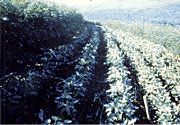
Hedgerow intercropping in the Philippines -- Leucaena leucocephala interplanted with beans
http://www.winrock.org/fnrm/factnet/factnet.htm
USDA National Agroforestry Center -- A partnership of the USDA Forest Service, Rocky Mountain Research Station and the USDA Natural Resources Conversation Service to promote agroforestry development. Technology Transfer & Applications, Research & Development, International Technology Exchange. Publications, information and resources.
http://www.unl.edu/nac/
"Live Fences" by Stefan D. Cherry & Erick C.M. Fernandes, Dept. of Soil, Crop & Atmospheric Sciences, Cornell University -- Resource-poor food crop farmers can't afford barbed wire for fences, and more and more farmers are using trees and shrubs to form dense, often thorny, hedges to protect their crops. These live fences control the movement of animals and people, and provide many extra benefits you don't get from barbed wire: fuelwood, fodder and food, wind breaks, soil enrichment and more, depending on the species. Online:
http://ppathw3.cals.cornell.edu/mba_project/livefence.html
See also Live Fences, Overstory #38 (free on-line journal focusing on trees and crops in agroforestry)
http://www.agroforester.com/overstory/overstory38.html
"The Living Fence -- Its Role on the Small Farm" by Dr. Franklin W. Martin, 1991, ECHO Technical Note -- Small farms need fences, and fences of living poles reduce costs, last much longer and have many benefits. They are widely used in a wide range of ecological situations, from very dry to rain forest conditions. Suitable plant materials are available for almost all ecological conditions. Other benefits: firewood, fertilizer, feed, food, fibers, shade, construction materials, medicines, windbreaks. Includes tables of species suitable for living fences. Online (Acrobat file):
http://www.echotech.org/mambo/images/DocMan/LivingFe.PDF
California Rare Fruit Growers (CRFG) is the largest amateur fruit-growing organization in the world. Fruit Facts online -- botanical identification, plant description and culture notes, characteristics of cultivars for 43 fruit varieties -- Common Names, Origin, Species, Related species, Adaptation; Description: Growth Habit, Foliage, Flowers, Fruits; Culture: Location, Soil, Irrigation, Fertilization, Frost Protection, Pruning, Propagation, Pests and Diseases, Fruit Harvest; Cultivars; Further Reading, and a direct link to Index of CRFG Publications, 1969--89. Also The Fruit Gardener magazine, descriptions of 250 rare and unusual edible plants, Seed Bank, the CRFG Fruit List -- Common Name, Genus species, Family, and Fruit Cultural Data, by genus name. Plus a large set of fruit and related links. Exhaustive! Excellent resource.
http://www.crfg.org/
 "The Backyard Orchardist: A Complete Guide to Growing Fruit Trees in the Home Garden" by Stella Otto. revised edition 1995, Otto Graphics, ISBN 0963452037
"The Backyard Orchardist: A Complete Guide to Growing Fruit Trees in the Home Garden" by Stella Otto. revised edition 1995, Otto Graphics, ISBN 0963452037
Step-by-step guidance from a true expert on how to start your orchard -- planning, soil, tree selection for your climate, planting, pruning, pest management, harvesting and storing, everything you need to know. Buy at Amazon.com: The Backyard Orchardist
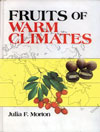 "Fruits of Warm Climates" by Julia F. Morton, ISBN: 0-9610184-1-0
"Fruits of Warm Climates" by Julia F. Morton, ISBN: 0-9610184-1-0
Julia F. Morton is Research Professor of Biology and Director of the Morton Collectanea, University of Miami, a research and information center devoted to economic botany. Covers 124 species, with an extensive bibliography; the entry for each species is a minor essay, with detailed treatment under Description, Origin and Distribution, Varieties, Climate, Soil, Propagation, Culture, Keeping Quality, Pests and Diseases, Food Uses, Other Uses. The approach is global -- Uses, for instance, covers the practices of traditional peoples throughout the world, including medical uses. Ms Morton provides a real wealth of information from her long experience of the subject. With photographs. Full text online:
http://www.hort.purdue.edu/newcrop/morton/index.html
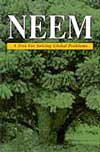 "Neem: A Tree For Solving Global Problems" National Research Council, 1992, National Academy Press, ISBN 0309046866
"Neem: A Tree For Solving Global Problems" National Research Council, 1992, National Academy Press, ISBN 0309046866
The wonder tree , traditionally called "the village pharmacy" in its native India. Neem provides a powerful pesticide that appears completely nontoxic to humans, mammals, and beneficial insects. In hot dry areas that are otherwise barren it gives ample shade and firewood year round. It is easy to establish and maintain. In India it is used to clean gums and teeth and is known to relieve a host of different pains, fevers, infections and other complaints -- it even has contraceptive properties. Yet neem remains relatively unknown and little utilized. Read it online (free) at the National Academy Press:
http://www.nap.edu/books/0309046866/html/
Buy the book at Amazon.com: Neem: A Tree for Solving Global ProblemsBamboo
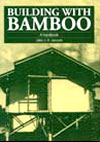 "Building With Bamboo" by Jules J. A. Janssen, 1995 -- This handbook brings together the practical experience of engineers working in the field, and research programs testing the properties of bamboo. Shows how bamboo has been used in different designs in developing countries and describes the varying properties and uses of different types of bamboo. How bamboo can be harvested, seasoned and jointed to form walls, doors and windows, roofs, floors, ceilings, roof trusses and bridges, and how to weave bamboo. Experiences of Dutch engineers in colonial Indonesia long ago building houses, roads and bridges, combined with similar original English material, plus the results of modem research programs, with the addition of the latest knowledge and a case study from Costa Rica. Buy at Amazon.com: Building With Bamboo
"Building With Bamboo" by Jules J. A. Janssen, 1995 -- This handbook brings together the practical experience of engineers working in the field, and research programs testing the properties of bamboo. Shows how bamboo has been used in different designs in developing countries and describes the varying properties and uses of different types of bamboo. How bamboo can be harvested, seasoned and jointed to form walls, doors and windows, roofs, floors, ceilings, roof trusses and bridges, and how to weave bamboo. Experiences of Dutch engineers in colonial Indonesia long ago building houses, roads and bridges, combined with similar original English material, plus the results of modem research programs, with the addition of the latest knowledge and a case study from Costa Rica. Buy at Amazon.com: Building With Bamboo
Bamboo as a Building Material, by P.A. McClure, Office of International Affairs, US Department of Housing and Urban Development, 1953, 58 pages. Download the complete book free from the CD3WD online 3rd World library (16.1Mb pdf):
http://www.fastonline.org/CD3WD_40/JF/433/25-585.pdf
A Series of Articles on the Use of Bamboo in Building Construction, collected by Dr. Jules J.A. Janssen, TOOL Foundation, the Netherlands, 1987, 165 pages. Techniques and designs, well-illustrated with photographs and line-drawings. Download the complete book free from the CD3WD online 3rd World library (18.7Mb pdf):
http://www.fastonline.org/CD3WD_40/JF/434/25-658.pdf
When you've lived in the East for awhile, you begin to wonder how life was ever possible without bamboo. In Hong Kong they still build 50-storey buildings with bamboo scaffolding:
it's strong, light, and flexible, so it doesn't blow away in typhoons.
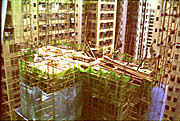
High-rise bamboo scaffolding in Hong Kong...
On a small farm, bamboo is extremely useful. Small farmers who depend on it (you soon will) plant at least two varieties. Most varieties flower every 30 years, others every 15, 45, 60, or even 120 years -- always in multiples of 15 years, for some reason. Then it dies back for five years or so -- no bamboo. So you need different varieties.
All bamboo plants of the same variety, wherever they might be in the world, flower on the same day. Just think of that.

... 25 floors up, 10 to go, and no safety harness
Apart from the poles, bamboo leaves make fine hay with a high protein content. And bamboos are beautiful, the groves make lovely creakings in the breeze. Its infinity of uses is only limited by the imagination. Rudolf Diesel's first compression ignition engine was inspired by a traditional firemaker tribesmen made from bamboo. One bamboo website lists "Uses of bamboo". It might be easier to list things you can't use it for.
http://kauai.net/bambooweb/
bambooa2z.html
Bamboo is not just a tropical plant, there are varieties for most climates -- there are more than a thousand varieties of bamboo (and they've never been crossed, because of their weird flowering habits).
Bamboos in Agroforestry -- The Overstory #30: Agroforestry (free on-line journal focusing on trees and crops in agroforestry):
http://www.agroforester.com/overstory/overstory30.html
 Bamboo: A Multipurpose Agroforestry Crop by Steve Diver of Appropriate Technology Transfer for Rural Areas (ATTRA) -- information and resources on bamboo agroforestry from ATTRA, particularly in temperate regions.
Bamboo: A Multipurpose Agroforestry Crop by Steve Diver of Appropriate Technology Transfer for Rural Areas (ATTRA) -- information and resources on bamboo agroforestry from ATTRA, particularly in temperate regions.
http://attra.ncat.org/attra-pub/bamboo.html
Bamboo and Rattan Facts from the International Network for Bamboo and Rattan (INBAR) -- "A single bamboo clump can produce up to 15 kilometres of usable pole (up to 30 cm in diameter) in its lifetime."
http://www.inbar.int/Board.asp?Boardid=173
Bamboo Web
http://www.kauai.net/bambooweb/bamboo.html
Bambus-Centrum is a German site, worldwide bamboo links.
http://www.bambus.de/index.html
American Bamboo Society
http://www.americanbamboo.org
Bamboo Society of Australia
http://www.bamboo.org.au
European Bamboo Society -- links
http://www.bamboosociety.org/links.html
Lewis Bamboo Groves in Alabama has over 80 varieties of cold-hardy bamboo.
http://www.lewisbamboo.com/
Burt Associates says there's a bamboo suited for every climate and has an online MiniGuide to Bamboo with plant descriptions and pictures. Online orders.
http://www.bamboos.com/
jmbamboo Bamboo Nursery -- US-based nursery supplying cold-hardy bamboo for screens, gardens, and landscapes. Most are spreading, evergreen bamboos, ranges in size from tiny groundcovers to towering giants, also rare or hard to find bamboos. Books on bamboo, FAQ, good information on how bamboo grows, planting and growing, controlling bamboo, what to do if it flowers, more.
http://www.jmbamboo.com/
Small farms
Small farm resources
Community-supported farms
Farming with trees
Farming with animals
Pasture
Pigs for small farms
Poultry for small farms
Aquaculture for small farms
Composting for small farms
Controlling weeds and pests
Small farms library
City farms
Organic gardening
Building a square foot garden
Plant spacing guides
No ground? Use containers
When to sow what
Seeds
Garden pond
Gardening resources
Composting
Making compost
Composting resources
Composting indoors
Vermicomposting
Humanure
Composting for small farms